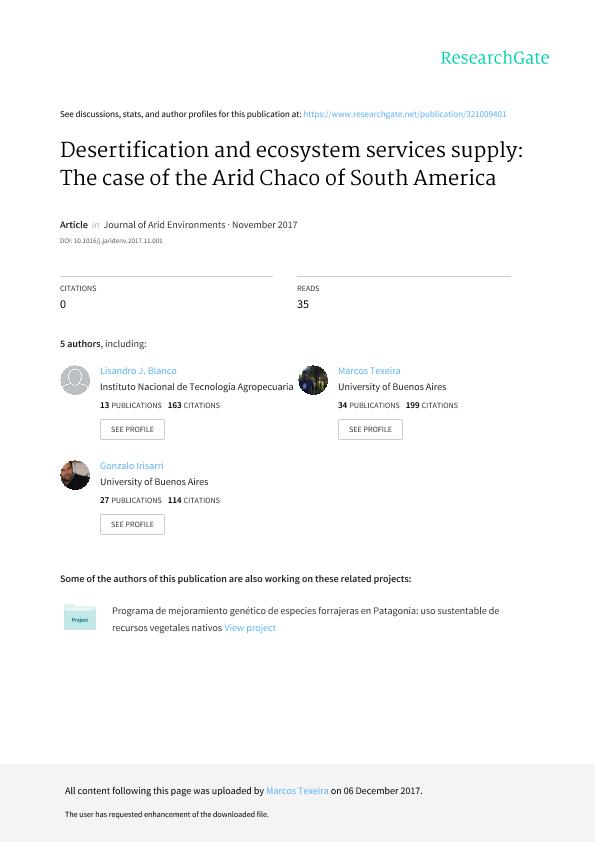Mostrar el registro sencillo del ítem
dc.contributor.author
Verón, Santiago Ramón

dc.contributor.author
Blanco, Lisandro Javier

dc.contributor.author
Texeira González, Marcos Alexis

dc.contributor.author
Irisarri, Jorge Gonzalo Nicolás

dc.contributor.author
Paruelo, José

dc.date.available
2018-08-21T14:48:54Z
dc.date.issued
2017-12
dc.identifier.citation
Verón, Santiago Ramón; Blanco, Lisandro Javier; Texeira González, Marcos Alexis; Irisarri, Jorge Gonzalo Nicolás; Paruelo, José; Desertification and ecosystem services supply: The case of the Arid Chaco of South America; Academic Press Ltd - Elsevier Science Ltd; Journal of Arid Environments; 12-2017
dc.identifier.issn
0140-1963
dc.identifier.uri
http://hdl.handle.net/11336/56315
dc.description.abstract
New integrated perspectives are increasingly needed to bridge the gap between biophysical and ecosystem services' based assessments of desertification. For a vast area of the dry Chaco region we sought to: (1) assess the spatial extent of four syndromes of vegetation change, associated with human or climatic drivers and (2) estimate and compare the supply of ecosystem services among these syndromes. We used a remote sensing approach based on the growing season -October to March- normalized difference vegetation index from MODIS, and climatological datasets from 2003 to 2013 to estimate: i) precipitation use efficiency, ii) precipitation marginal response, iii) the temporal trends of the residuals from the normalized difference vegetation index - annual precipitation linear relationship, and iv) the ecosystem services provision index. We diagnosed vegetation syndromes based on the difference between actual and reference sites' precipitation use efficiency and precipitation marginal response. Negative residuals trends were interpreted as vegetation changes driven by inadequate human management. The ecosystem services provision index assumes that ecosystem services supply varies positively with primary production and a negatively with its seasonal variability. Our results showed that 9.1% of the observed area belonged to the vegetation improvement syndrome - positive Delta precipitation use efficiency and Delta precipitation marginal response - while 3.4% were classified as vegetation cover reduction -negative Delta precipitation use efficiency and Delta precipitation marginal response. In turn, 10.5% and 2% of the study area fell within the increment in herbaceous vegetation -negative Delta precipitation use efficiency and positive Delta precipitation marginal response - and woody encroachment syndromes - positive precipitation use efficiency and negative precipitation marginal response - respectively. Human management did not have a uniform impact as all 4 syndromes displayed positive and negative residuals trends. Contrary to our expectations, there was no apparent association between vegetation syndromes and the supply of ecosystem services as estimated by the ecosystem services provision index. This study serves as a prototype to remotely assess ecosystem properties indicative of different vegetation syndromes and the associated supply of ecosystem services in dryland regions.
dc.format
application/pdf
dc.language.iso
eng
dc.publisher
Academic Press Ltd - Elsevier Science Ltd

dc.rights
info:eu-repo/semantics/openAccess
dc.rights.uri
https://creativecommons.org/licenses/by-nc-sa/2.5/ar/
dc.subject
Ecosystem Services Provision Index
dc.subject
Modis
dc.subject
Precipitation Marginal Response
dc.subject
Precipitation Use Efficiency
dc.subject
Restrends
dc.subject.classification
Oceanografía, Hidrología, Recursos Hídricos

dc.subject.classification
Ciencias de la Tierra y relacionadas con el Medio Ambiente

dc.subject.classification
CIENCIAS NATURALES Y EXACTAS

dc.title
Desertification and ecosystem services supply: The case of the Arid Chaco of South America
dc.type
info:eu-repo/semantics/article
dc.type
info:ar-repo/semantics/artículo
dc.type
info:eu-repo/semantics/publishedVersion
dc.date.updated
2018-08-16T15:12:08Z
dc.journal.pais
Países Bajos

dc.journal.ciudad
Amsterdam
dc.description.fil
Fil: Verón, Santiago Ramón. Consejo Nacional de Investigaciones Científicas y Técnicas; Argentina. Instituto Nacional de Tecnología Agropecuaria. Centro de Investigación de Recursos Naturales. Instituto de Clima y Agua; Argentina
dc.description.fil
Fil: Blanco, Lisandro Javier. Instituto Nacional de Tecnología Agropecuaria. Centro Regional Catamarca-La Rioja. Estación Experimental Agropecuaria La Rioja; Argentina
dc.description.fil
Fil: Texeira González, Marcos Alexis. Consejo Nacional de Investigaciones Científicas y Técnicas. Oficina de Coordinación Administrativa Parque Centenario. Instituto de Investigaciones Fisiológicas y Ecológicas Vinculadas a la Agricultura. Universidad de Buenos Aires. Facultad de Agronomía; Argentina
dc.description.fil
Fil: Irisarri, Jorge Gonzalo Nicolás. Consejo Nacional de Investigaciones Científicas y Técnicas. Oficina de Coordinación Administrativa Parque Centenario. Instituto de Investigaciones Fisiológicas y Ecológicas Vinculadas a la Agricultura. Universidad de Buenos Aires. Facultad de Agronomía; Argentina
dc.description.fil
Fil: Paruelo, José. Consejo Nacional de Investigaciones Científicas y Técnicas. Oficina de Coordinación Administrativa Parque Centenario. Instituto de Investigaciones Fisiológicas y Ecológicas Vinculadas a la Agricultura. Universidad de Buenos Aires. Facultad de Agronomía; Argentina
dc.journal.title
Journal of Arid Environments

dc.relation.alternativeid
info:eu-repo/semantics/altIdentifier/doi/https://dx.doi.org/10.1016/j.jaridenv.2017.11.001
dc.relation.alternativeid
info:eu-repo/semantics/altIdentifier/url/https://www.sciencedirect.com/science/article/pii/S0140196317301994
Archivos asociados
